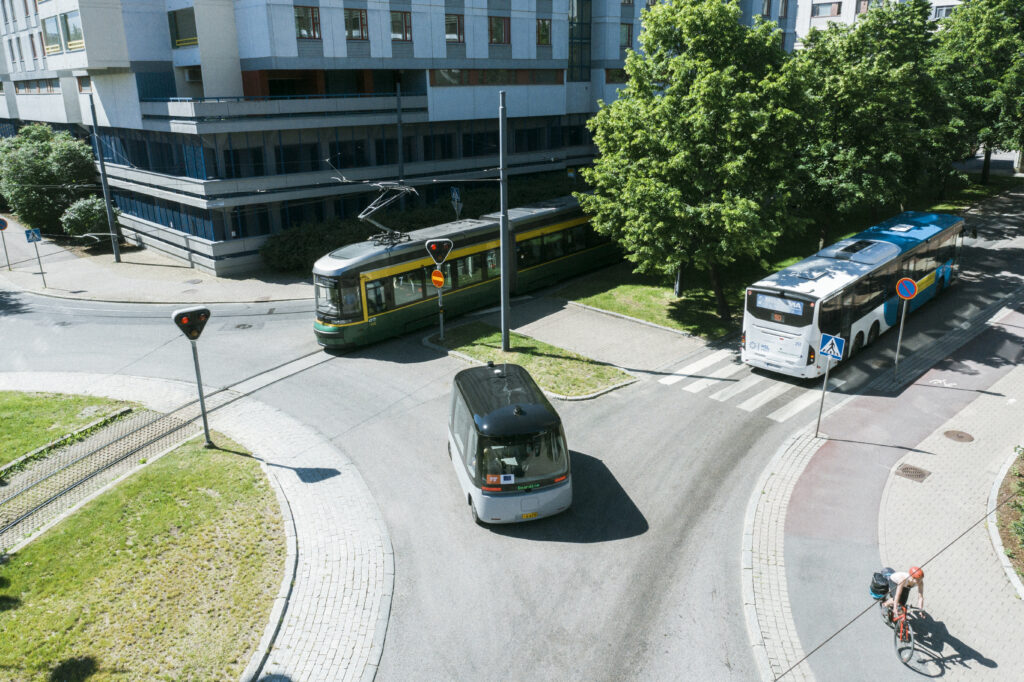Automation is increasing in all areas of society, including transport. Changes are expected to be fastest in road traffic and public transport where the first applications – self-driving lorries and their queue driving applications, autopilots for the motorway environment, as well as robot buses and taxes – are expected to enter the market in the early 2020s. However, the views of experts are somewhat contradictory, which is why an exact estimate cannot be given.
The safety potential of such automation level 4 applications is significant, as they are expected to eliminate up to half of road fatalities once the penetration is sufficiently high. Applications at the lower automation levels also provide traffic safety benefits. At first, the automation applications will only work in operating environments specifically built for them, which are expected to expand fairly quickly, however, partly through investments made by road operators. Automation is a major factor of change especially in terms of the production costs and service level of public transport services, as it will eliminate drivers and related costs.
Automation therefore offers interesting opportunities for the development of regional public transport. It has been estimated that the role of minibuses and robot taxis in feeder services to support rail transport may be significant, at first in suburban areas where the operating environment requirements can be more easily reached than in the inner city, which is a challenging operating environment for self-driving vehicles due to the high volume of cyclists and pedestrians, for example.
Although the traffic safety and service level development potential is huge, the development of automation also involves plenty of questions and even some clear risks from the perspective of the goals set by the city of Helsinki. The most major question in terms of the impact is how selfdriving passenger vehicles will enter the consumer market – as a service or to be privately purchased. If the price level of self-driving passenger vehicles is low enough for the average consumer to be able to purchase one on their own, the development may damage – through the lowering of the value of travel time – the competitive ability of rail transport and cause congestion in the road network, regardless of the potential additional capacity provided by the self-driving vehicles.
Another clear uncertainty is related to the arrangement of automatic transport services. It is almost certain that commercial automatic transport services will be created on the market, and the affordability of such services will depend on the above-mentioned mechanisms. Such services can excellently supplement the public transport feeder services, in which case the fully marketbased services can have a positive impact.
However, if such services do not operate as part of the regional rail-based system but offer an affordable and attractive alternative to the system, the development may be a threat to the competitive ability and financing base of the regional public transport system. The current driver-based commercial transport services have already reduced public transport passenger volumes in New York, for example (New York Times 2018).
Automation of the transport system is a major factor of change. After the testing phase – and already during this phase – transport policy control and regulation, as well as other methods to prevent the realisation of the above-mentioned threats will be necessary.
As published in the Helsinki Intelligent Transport System Development Programme 2030
Cooperation between the city of Helsinki, HSL, the state and other municipalities in the region in the generation of a policy on self-driving vehicles will also be necessary. Different types of pricing models based on utilisation of the street space must be reviewed at the latest in this connection. It is likely that self-driving vehicles will become more common quite slowly in the 2020s, because the renewal of the vehicle stock is a slow process.
It has been estimated that in 2030, only a couple of per cent of the vehicle stock will consist of self-driving vehicles (level 4), and self-driving vehicles will not become more common until the 2030s. The transition period will be long, and during this time the transport system must serve vehicles of a low automation level and vehicles of a higher automation level. It is likely that road management costs will increase and the benefits from automation will not be realised at the transport system level during the first stages of the transition period. Furthermore, providing/constructing infrastructure dedicated to self-driving vehicles in the densely built urban environment is not considered realistic. It is likely that the need for traffic control will increase during the transition period, because different types of disturbances will become more common, for example.
The possible disturbances during the transition period must be accepted and active measures to mitigate them must be taken. Means to accelerate the renewal of the vehicle stock will be integral to the transport policy. On the other hand, servitization of transport is a trend that will accelerate the renewal of the vehicle stock and thus the implementation of new technologies. Cooperative Intelligent Transport Systems (C-ITS), or interactive vehicles that can communicate with other vehicles and the infrastructure, are part of the development of transport automation. Implementation of C-ITS applications will start sooner than the implementation of level 4 automation due to control by the European Commission, for example, and the applications will become more common quite quickly in the 2020s due to retrofit and mobile solutions.
It has been estimated that C-ITS applications will reduce accidents by up to 10%, as they offer drivers exact real-time situational awareness and integrate warnings into lower automation level applications (such as automatic emergency brakes). C-ITS also offers advanced information and navigation services in vehicle devices, which is a key step towards the transfer of traffic information and control from the roadside to the vehicle. In addition, the road operator’s role is significant in the case of C-ITS services, as the road operator maintains the traffic light system, for example.
References
1
Helsinki Intelligent Transport System Development Programme 2030
Photographer Jussi Hellsten

